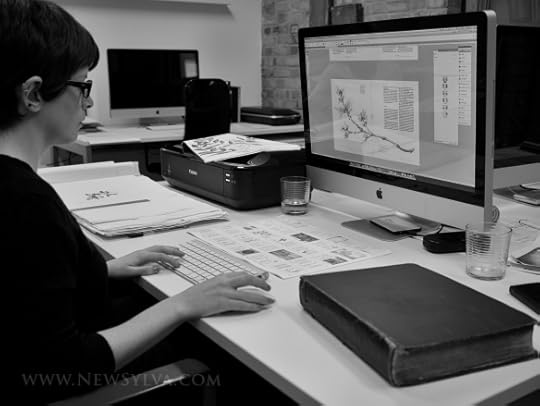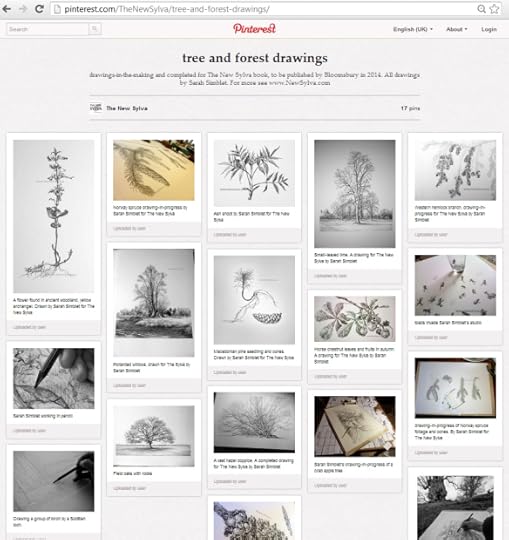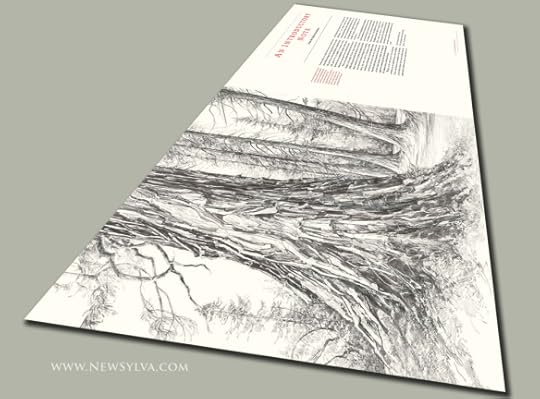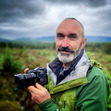Gabriel Hemery's Blog: Gabriel Hemery, page 35
September 29, 2013
Sylvan reflections by copy-editor Rachael Oakden
Copy-editor Rachael Oakden writes about her experience working on The New Sylva.
Rachael Oakden: copy-editor of The New Sylva
As the freelance editor commissioned by Bloomsbury to copy-edit The New Sylva, I have been immersed in the world of forestry and wood culture for the past six months. It is a world that I was unfamiliar with before Gabriel Hemery’s unedited manuscript arrived in my inbox. Back in March 2013, I have to confess, I had a preconception of The New Sylva as being a beautifully illustrated book about British trees. It was only when I read the opening chapters that I understood the book’s more complex and ambitious purpose: to be a celebration of the art and science of forestry, with an urgent environmental message.
You might wonder why a non-expert was chosen to work on such a book. Well, the aim of the book is to communicate the vital importance of forest trees and the people who manage them to our landscapes, society, economy and future. It is designed to have a wide appeal, both to non-specialist general readers and to those with professional or personal interest: foresters, woodland owners, woodworkers, for example. As copy-editor, my role is to be the ‘typical’ reader, to filter the manuscript through non-expert eyes. If I don’t understand a technical term or concept, the chances are that other non-specialist readers won’t. If I cannot follow the thread of an argument, or visualise the leaf shape or branching pattern that the author is trying to describe, for example, it’s a sign that a particular sentence or paragraph isn’t working. However, it’s important not to go far and oversimplify things. As an expert author, Gabriel’s aim is to enlighten and inspire readers, to share his knowledge and passion about forest trees and their uses. The copy-editing process is all about getting the balance right.
Using the Track Changes facility in Microsoft Word, I worked through the manuscript chapter by chapter, making amendments, suggesting deletions and drawing attention to areas where I felt more explanation was needed. I also double-checked facts – dates, places, spellings (all those multisyllabic Latin names) – and made editorial tweaks to help the text skip along with good rhythm and pace. This ‘first edit’ was sent to Gabriel, who would accept or reject my changes, supply extra words and make clarifications where necessary. Then I worked on a ‘second edit’, which, once approved, became a ‘final’, to be sent to the commissioning editor and designers. The author has the last word on any edits, of course, and when Gabriel disagreed with one of my deletions or oversimplifications he would always explain clearly – and courteously – why he was rejecting it!
Working on The New Sylva has really sharpened my perception of the trees around me – a pleasure enhanced a few months into the edit when Sarah Simblet sent me copies of some of her beautiful drawings. Before working on the book, I was a non-expert admirer of trees in the landscape. Six months later, however, during family dog walks in our local woods, I am frequently to be found staring at leaves and sniffing needles in an attempt to identify conifers and broadleaves. On one recent outing, my young son asked me why I was hugging an oak tree. Well, obviously, I was attempting to estimate its dbh (diameter at breast height) and wondering who planted it, when they planted it, and for what purpose. Copy-editing The New Sylva has given me an insight into the world of forestry and a cheering glimpse towards a future that may be brighter because of wood-based technologies. I cannot wait to see the final illustrated book.
Rachael Oakden, September 2013
Rachael Oakden began her career in magazines, working as a sub-editor, writer and commissioning editor on titles including Country Life, Country Living and Coast. Now a freelance editor and writer, she has copy-edited non-fiction titles including England in Particular by Sue Clifford and Angela King (Hodder & Stoughton, 2006), Villages of Britain by Clive Aslet (Bloomsbury, 2010) and Wild Flowers by Sarah Raven (Bloomsbury, 2011). Rachael also writes for magazines and newspapers about people and places in the British countryside. She lives in the Eden Valley, Cumbria with her husband and two sons.







September 21, 2013
Copy-editing, design, proofreading and final deadlines
Regular readers of this blog will know that the authors have not posted for some time. We’ve been working flat-out to meet the demanding publication schedule and progressing through several major steps in the editorial cycle.
Copy-editing was completed at the end of August. This is the process in which the manuscript is checked for accuracy and for consistency in formatting and style. We will explain more about this process in a post to follow soon.
During the summer several meetings with designers Grade Design have taken place in London, involving both authors, the design team, and Senior Editor Natalie Hunt from Bloomsbury.

Working on The New Sylva with Grade Design. Louise Evans inserts some text on a spread in the Ash section. Note the author’s copy of Evelyn’s Sylva in the foreground – a constant inspiration.
The original hand-drawn flatplan, created by Sarah Simblet, has been superseded by a digital version. Louise Evans from Grade Design, overseen by creative director Pete Dawson, has been keying in the manuscript, provided in Microsoft Word, into the professional software Adobe InDesign. As each new drawing is submitted by Sarah to Grade Design, it is first roughly scanned in so that its position can be decided. Later all the drawings will be photographed at very high resolution and these will be used to create the final book design.
Creating this working design of the book revealed instances where text was over-long or too short for a spread. Dealing with the latter meant writing additional sections so that text on any single page did not fall too short. A working design of the book has also permitted the writing of all cross references, and the table of contents. Fine adjustment of the design is ongoing but it seems likely that book length will be 400 pages.
The authors are currently proof reading through the manuscript twice, with improvements made between each version. Once the final text is agreed it will be checked by a professional proofreader and indexed by a specialist. Sarah will be working on remaining drawings until the end of November.







June 26, 2013
Pinterest board launched for The New Sylva
We’ve launched a Pinterest board for The New Sylva, so that many of the images of Sarah Simblet’s drawings for the book can be viewed from one place.

Some of the images on Pinterest for The New Sylva







June 22, 2013
Author speaks at launch of Box project

Gabriel Hemery speaking at the launch of the Chilterns Box Woodland Project. Notice the poster alongside of co-author Sarah Simblet drawing in box woodland for The New Sylva. Photo: Chris Smith Photography
Yesterday Gabriel Hemery was an invited speaker at the opening of the Chilterns Box Woodland Project.
“I need not speak much of the uses of this tree, (growing in time to considerable stature) so continually sought after for many utensils, being so hard, close and pondrous as to sink like lead in water …”
He read excerpts from Evelyn’s original text (above), and from the now completed text about Box (Buxus sempervirens) written for The New Sylva, to an audience of artists, musicians, landowners, naturalists and others.
Read more about the Chilterns Box Woodland Project







June 8, 2013
First sample chapters produced
Our deadline to complete copy editing is the end of June, so Gabriel Hemery has been working hard with the copy editor to finish on time. Meanwhile, the authors have also been working with the team at Bloomsbury Publishing to produce the first sample chapters. This is the first time that text and image have been fully combined so it was exciting for all the team to work on this.
The samples have been prepared in readiness for an approach to a VIP to write the foreword for The New Sylva. We can’t tell you more than this for now but meanwhile here’s a sneak preview of one of the pages:

A sample page from The New Sylva







June 6, 2013
Gabriel Hemery talks about the making of The New Sylva
Gabriel Hemery will be talking about the making of The New Sylva at the Chilterns Woodland conference tomorrow. More information and last-minute booking is available here







Gabriel Hemery
I’m a silvologist—or forest scientist—and a published author. I’m also a keen amateur photographer with a passion for tr Welcome to my silvological blog featuring the study of trees, forests and woods.
I’m a silvologist—or forest scientist—and a published author. I’m also a keen amateur photographer with a passion for trees. ...more
- Gabriel Hemery's profile
- 14 followers





